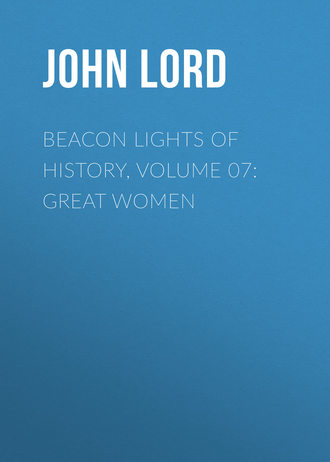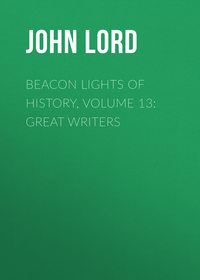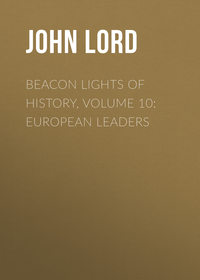 полная версия
полная версияBeacon Lights of History, Volume 07: Great Women
The last of the series, "Janet's Repentance," is, I think, the best. The hero is again a clergyman, an evangelical, whose life is one long succession of protracted martyrdoms,–an expiation to atone for the desertion of a girl whom he had loved and ruined while in college. Here we see, for the first time in George Eliot's writings, that inexorable fate which pursues wrong-doing, and which so prominently stands out in all her novels. The singular thing is that she–at this time an advanced liberal–should have made the sinning young man, in the depth of his remorse, to find relief in that view of Christianity which is expounded by the Calvinists. But here she is faithful and true to the teaching of those by whom she was educated; and it is remarkable that her art enables her apparently to enter into the spiritual experiences of an evangelical curate with which she had no sympathy. She does not mock or deride, but seems to respect the religion which she had herself repudiated.
And the same truths which consoled the hard-working, self-denying curate are also made to redeem Janet herself, and secure for her a true repentance. This heroine of the story is the wife of a drunken, brutal village doctor, who dies of delirium tremens; she also is the slave of the same degrading habit which destroys her husband, but, unlike him, is a victim of remorse and shame. In her despair she seeks advice and consolation from the minister whom she had ridiculed and despised; and through him she is led to seek that divine aid which alone enables a confirmed drunkard to conquer what by mere force of will is an unconquerable habit. And here George Eliot–for that is the name she now goes by–is in accord with the profound experience of many.
The whole tale, though short, is a triumph of art and abounds with acute observations of human nature. It is a perfect picture of village life, with its gossip, its jealousies, its enmities, and its religious quarrels, showing on the part of the author an extraordinary knowledge of theological controversies and the religious movements of the early part of the nineteenth century. So vivid is her description of rural life, that the tale is really an historical painting, like the Dutch pictures of the seventeenth century, to be valued as an accurate delineation rather than a mere imaginary scene. Madonnas, saints, and such like pictures which fill the churches of Italy and Spain, works of the old masters, are now chiefly prized for their grace of form and richness of coloring,–exhibitions of ideal beauty, charming as creations, but not such as we see in real life; George Eliot's novels, on the contrary, are not works of imagination, like the frescos in the Sistine Chapel, but copies of real life, like those of Wilkie and Teniers, which we value for their fidelity to Nature. And in regard to the passion of love, she does not portray it, as in the old-fashioned novels, leading to fortunate marriages with squires and baronets; but she generally dissects it, unravels it, and attempts to penetrate its mysteries,–a work decidedly more psychological than romantic or sentimental, and hence more interesting to scholars and thinkers than to ordinary readers, who delight in thrilling adventures and exciting narrations.
The "Scenes of Clerical Life" were followed the next year by "Adam Bede," which created a great impression on the cultivated mind of England and America. It did not create what is called a "sensation." I doubt if it was even popular with the generality of readers, nor was the sale rapid at first; but the critics saw that a new star of extraordinary brilliancy had arisen in the literary horizon. The unknown author entered, as she did in "Janet's Repentance," an entirely new field, with wonderful insight into the common life of uninteresting people, with a peculiar humor, great power of description, rare felicity of dialogue, and a deep undertone of serious and earnest reflection. And yet I confess, that when I first read "Adam Bede," twenty-five years ago, I was not much interested, and I wondered why others were. It was not dramatic enough to excite me. Many parts of it were tedious. It seemed to me to be too much spun out, and its minuteness of detail wearied me. There was no great plot and no grand characters; nothing heroic, no rapidity of movement; nothing to keep me from laying the book down when the dinner-bell rang, or when the time came to go to bed. I did not then see the great artistic excellence of the book, and I did not care for a description of obscure people in the Midland Counties of England,–which, by the way, suggests a reason why "Adam Bede" cannot be appreciated by Americans as it is by the English people themselves, who every day see the characters described, and hear their dialect, and know their sorrows, and sympathize with their privations and labors. But after a closer and more critical study of the novel I have come to see merits that before escaped my eye. It is a study, a picture of humble English life, painted by the hand of a master, to be enjoyed most by people of critical discernment, and to be valued for its rare fidelity to Nature. It is of more true historical interest than many novels which are called historical,–even as the paintings of Rembrandt are more truly historical than those of Horace Vernet, since the former painted life as it really was in his day. Imaginative pictures are not those which are most prized by modern artists, or those pictures which make every woman look like an angel and every man like a hero,–like those of Gainsborough or Reynolds,–however flattering they may be to those who pay for them.
I need not dwell on characters so well known as those painted in "Adam Bede." The hero is a painstaking, faithful journeyman carpenter, desirous of doing good work. Scotland and England abound in such men, and so did New England fifty years ago. This honest mechanic falls in love with a pretty but vain, empty, silly, selfish girl of his own class; but she had already fallen under the spell of the young squire of the village,–a good-natured fellow, of generous impulses, but essentially selfish and thoughtless, and utterly unable to cope with his duty. The carpenter, when he finds it out, gives vent to his wrath and jealousy, as is natural, and picks a quarrel with the squire and knocks him down,–an act of violence on the part of the inferior in rank not very common in England. The squire abandons his victim after ruining her character,–not an uncommon thing among young aristocrats,–and the girl strangely accepts the renewed attentions of her first lover, until the logic of events compels her to run away from home and become a vagrant. The tragic and interesting part of the novel is a vivid painting of the terrible sufferings of the ruined girl in her desolate wanderings, and of her trial for abandoning her infant child to death,–the inexorable law of fate driving the sinner into the realms of darkness and shame. The story closes with the prosaic marriage of Adam Bede to Dinah Morris,–a Methodist preacher, who falls in love with him instead of his more pious brother Seth, who adores her. But the love of Adam and Dinah for one another is more spiritualized than is common,–is very beautiful, indeed, showing how love's divine elements can animate the human soul in all conditions of life. In the fervid spiritualism of Dinah's love for Adam we are reminded of a Saint Theresa seeking to be united with her divine spouse. Dinah is a religious rhapsodist, seeking wisdom and guidance in prayer; and the divine will is in accordance with her desires. "My soul," said she to Adam, "is so knit to yours that it is but a divided life if I live without you."
The most amusing and finely-drawn character in this novel is a secondary one,–Mrs. Poyser,–but painted with a vividness which Scott never excelled, and with a wealth of humor which Fielding never equalled. It is the wit and humor which George Eliot has presented in this inimitable character which make the book so attractive to the English, who enjoy these more than the Americans,–the latter delighting rather in what is grotesque and extravagant, like the elaborate absurdities of "Mark Twain." But this humor is more than that of a shrewd and thrifty English farmer's wife; it belongs to human nature. We have seen such voluble sharp, sagacious, ironical, and worldly women among the farm-houses of New England, and heard them use language, when excited or indignant, equally idiomatic, though not particularly choice. Strike out the humor of this novel and the interest we are made to feel in commonplace people, and the story would not be a remarkable one.
"Adam Bede" was followed in a year by "The Mill on the Floss," the scene of which is also laid in a country village, where are some well-to-do people, mostly vulgar and uninteresting. This novel is to me more powerful than the one which preceded it,–having more faults, perhaps, but presenting more striking characters. As usual with George Eliot, her plot in this story is poor, involving improbable incidents and catastrophes. She is always unfortunate in her attempts to extricate her heroes and heroines from entangling difficulties. Invention is not her forte; she is weak when she departs from realistic figures. She is strongest in what she has seen, not in what she imagines; and here she is the opposite of Dickens, who paints from imagination. There was never such a man as Pickwick or Barnaby Rudge. Sir Walter Scott created characters,–like Jeannie Deans,–but they are as true to life as Sir John Falstaff.
Maggie Tulliver is the heroine of this story, in whose intellectual developments George Eliot painted herself, as Madame De Staël describes her own restless soul-agitations in "Delphine" and "Corinne." Nothing in fiction is more natural and life-like than the school-days of Maggie, when she goes fishing with her tyrannical brother, and when the two children quarrel and make up,–she, affectionate and yielding; he, fitful and overbearing. Many girls are tyrannized over by their brothers, who are often exacting, claiming the guardianship which belongs only to parents. But Maggie yields to her obstinate brother as well as to her unreasonable and vindictive father, governed by a sense of duty, until, with her rapid intellectual development and lofty aspiration, she breaks loose in a measure from their withering influence, though not from technical obligations. She almost loves Philip Wakem, the son of the lawyer who ruined her father; yet out of regard to family ties she refuses, while she does not yet repel, his love. But her real passion is for Stephen Gurst, who was betrothed to her cousin, and who returned Maggie's love with intense fervor.
"Why did he love her? Curious fools, be still! Is human love the fruit of human will?"She knows she ought not to love this man, yet she combats her passion with poor success, allows herself to be compromised in her relations with him, and is only rescued by a supreme effort of self-renunciation,–a principle which runs through all George Eliot's novels, in which we see the doctrines of Buddha rather than those of Paul, although at times they seem to run into each other. Maggie erred in not closing the gate of her heart inexorably, and in not resisting the sway of a purely "physiological law." The vivid description of this sort of love, with its "strange agitations" and agonizing ecstasies, would have been denounced as immoral fifty years ago. The dénouement is an improbable catastrophe on a tidal river, in the rising floods of which Maggie and her brother are drowned,–a favorite way with the author in disposing of her heroes and heroines when she can no longer manage them.
The secondary characters of this novel are numerous, varied, and natural, and described with great felicity and humor. None of them are interesting people; in fact, most of them are very uninteresting,–vulgar, money-loving, material, purse-proud, selfish, such as are seen among those to whom money and worldly prosperity are everything, with no perception of what is lofty and disinterested, and on whom grand sentiments are lost,–yet kind-hearted in the main, and in the case of the Dobsons redeemed by a sort of family pride. The moral of the story is the usual one with George Eliot,–the conflict of duty with passion, and the inexorable fate which pursues the sinner. She brings out the power of conscience as forcibly as Hawthorne has done in his "Scarlet Letter."
The "Mill on the Floss" was soon followed by "Silas Marner," regarded by some as the gem of George Eliot's novels, and which certainly–though pathetic and sad, as all her novels are–does not leave on the mind so mournful an impression, since in its outcome we see redemption. The principal character–the poor, neglected, forlorn weaver–emerges at length from the Everlasting Nay into the Everlasting Yea; and he emerges by the power of love,–love for a little child whom he has rescued from the snow, the storm, and death. Driven by injustice to a solitary life, to abject penury, to despair, the solitary miser, gloating over his gold pieces,–which he has saved by the hardest privation, and in which he trusts,–finds himself robbed, without redress or sympathy; but in the end he is consoled for his loss in the love he bestows on a helpless orphan, who returns it with the most noble disinterestedness, and lives to be his solace and his pride. Nothing more touching has ever been written by man or woman than this short story, as full of pathos as "Adam Bede" is full of humor.
What is remarkable in this story is that the plot is exactly similar to that of "Jermola the Potter," the masterpiece of a famous Polish novelist,–a marvellous coincidence, or plagiarism, difficult to be explained. But Shakspeare, the most original of men, borrowed some of his plots from Italian writers; and Mirabeau appropriated the knowledge of men more learned than he, which by felicity of genius he made his own; and Webster, too, did the same thing. There is nothing new under the sun, except in the way of "putting things."
After the publication of the various novels pertaining to the rural and humble life of England, with which George Eliot was so well acquainted, into which she entered with so much sympathy, and which she so marvellously portrayed, she took a new departure, entering a field with which she was not so well acquainted, and of which she could only learn through books. The result was "Romola," the most ambitious, and in some respects the most remarkable, of all her works. It certainly is the most learned and elaborate. It is a philosophico-historical novel, the scene of which is laid in Florence at the time of Savonarola,–the period called the Renaissance, when art and literature were revived with great enthusiasm; a very interesting period, the glorious morning, as it were, of modern civilization.
This novel, the result of reading and reflection, necessarily called into exercise other faculties besides accurate observation,–even imagination and invention, for which she is not pre-eminently distinguished. In this novel, though interesting and instructive, we miss the humor and simplicity of the earlier works. It is overloaded with learning. Not one intelligent reader in a hundred has ever heard even the names of many of the eminent men to whom she alludes. It is full of digressions, and of reflections on scientific theories. Many of the chapters are dry and pedantic. It is too philosophical to be popular, too learned to be appreciated. As in some of her other stories, highly improbable events take place. The plot is not felicitous, and the ending is unsatisfactory. The Italian critics of the book are not, on the whole, complimentary. George Eliot essayed to do, with prodigious labor, what she had no special aptitude for. Carlyle in ten sentences would have made a more graphic picture of Savonarola. None of her historical characters stand out with the vividness with which Scott represented Queen Elizabeth and Mary, Queen of Scots, or with which even Bulwer painted Rienzi and the last of the Barons.
Critics do not admire historical novels, because they are neither history nor fiction. They mislead readers on important issues, and they are not so interesting as the masterpieces of Macaulay and Froude. Yet they have their uses. They give a superficial knowledge of great characters to those who will not read history. The field of history is too vast for ordinary people, who have no time for extensive reading even if they have the inclination.
The great historical personage whom George Eliot paints in "Romola" is Savonarola,–and I think faithfully, on the whole. In the main she coincides with Villani, the greatest authority. In some respects I should take issue with her. She makes the religion of the Florentine reformer to harmonize with her notions of self-renunciation. She makes him preach the "religion of humanity," which was certainly not taught in his day. He preached duty, indeed, and appealed to conscience; but he preached duty to God rather than to man. The majesty of a personal God, fearful in judgment and as represented by the old Jewish prophets, was the great idea of Savonarola's theology. His formula was something like this: "Punishment for sin is a divine judgment, not the effect of inexorable laws. Repentance is a necessity. Unless men repent of their sins, God will punish them. Unless Italy repents, it will be desolated by His vengeance." Catholic theology, which he never departed from, has ever recognized the supreme allegiance of man to his Maker, because He demands it. Even among the Jesuits, with their corrupted theology, the motto emblazoned on their standard was, Ad majorem dei gloriam. But the great Dominican preacher is made by George Eliot to be "the spokesman of humanity made divine, not of Deity made human." "Make your marriage vows," said he to Romola, "an offering to the great work by which sin and sorrow are made to cease."
But Savonarola is only a secondary character in the novel. He might as well have been left out altogether. The real hero and heroine are Romola and Tito; and they are identified with the life of the period, which is the Renaissance,–a movement more Pagan than Christian. These two characters may be called creations. Romola is an Italian woman, supposed to represent a learned and noble lady four hundred years ago. She has lofty purposes and aspirations; she is imbued with the philosophy of self-renunciation; her life is devoted to others,–first to her father, and then to humanity. But she is as cold as marble; she is the very reverse of Corinne. Even her love for Tito is made to vanish away on the first detection of his insincerity, although he is her husband. She becomes as hard and implacable as fate; and when she ceases to love her husband, she hates him and leaves him, and is only brought back by a sense of duty. Yet her hatred is incurable; and in her wretched disappointment she finds consolation only in a sort of stoicism. How far George Eliot's notions of immortality are brought out in the spiritual experiences of Romola I do not know; but the immortality of Romola is not that which is brought to light by the gospel: it is a vague and indefinite sentiment kindred to that of Indian sages,–that we live hereafter only in our teachings or deeds; that we are absorbed in the universal whole; that our immortality is the living in the hearts and minds of men, not personally hereafter among the redeemed To quote her own fine thought,–
"Oh, may I join the choir invisible In pulses stirred to generosity, In deeds of daring rectitude, in scorn For miserable aims that end in self, In thoughts sublime that pierce the night like stars, And, with their mild persistence, urge man's search To vaster issues!"Tito is a more natural character, good-natured, kind-hearted, with generous impulses. He is interesting in spite of his faults; he is accomplished, versatile, and brilliant. But he is inherently selfish, and has no moral courage. He gradually, in his egotism, becomes utterly false and treacherous, though not an ordinary villain. He is the creature of circumstances. His weakness leads to falsehood, and falsehood ends in crime; which crime pursues him with unrelenting vengeance,–not the agonies of remorse, for he has no conscience, but the vindictive and persevering hatred of his foster father, whom he robbed. The vengeance of Baldassare is almost preternatural; it surpasses the wrath of Achilles and the malignity of Shylock. It is the wrath of a demon, from which there is no escape; it would be tragical if the subject of it were greater. Though Tito perishes in an improbable way, he is yet the victim of the inexorable law of human souls.
But if "Romola" has faults, it has remarkable excellences. In this book George Eliot aspires to be a teacher of ethics and philosophy. She is not humorous, but intensely serious and thoughtful. She sometimes discourses like Epictetus:–
"And so, my Lillo," says she at the conclusion, "if you mean to act nobly, and seek to know the best things God has put within reach of man, you must learn to fix your mind on that end, and not on what will happen to you because of it. And remember, if you were to choose something lower, and make it the rule of your life to seek your own pleasure and escape what is disagreeable, calamity might come just the same; and it would be a calamity falling on a base mind,–which is the one form of sorrow that has no balm in it, and that may well make a man say, 'It would have been better for me if I had never been born.'"
Three years elapsed between the publication of "Romola" and that of "Felix Holt," which shows to what a strain the mind of George Eliot had been subjected in elaborating an historical novel. She now returns to her own peculiar field, in which her great successes had been made, and with which she was familiar; and yet even in her own field we miss now the genial humanity and inimitable humor of her earlier novels. In "Felix Holt" she deals with social and political problems in regard to which there is great difference of opinion; for the difficult questions of political economy have not yet been solved. Felix Holt is a political economist, but not a vulgar radical filled with discontent and envy. He is a mechanic, tolerably educated, and able to converse with intelligence on the projected reforms of the day, in cultivated language. He is high-minded and conscientious, but unpractical, and gets himself into difficulties, escaping penal servitude almost by miracle, for the crime of homicide. The heroine, Esther Lyon, is supposed to be the daughter of a Dissenting minister, who talks theology after the fashion of the divines of the seventeenth century; unknown to herself, however, she is really the daughter of the heir of large estates, and ultimately becomes acknowledged as such, but gives up wealth and social position to marry Felix Holt, who had made a vow of perpetual poverty. Such a self-renunciation is not common in England. Even a Paula would hardly have accepted such a lot; only one inspired with the philosophy of Marcus Aurelius would be capable of such a willing sacrifice,–very noble, but very improbable.
The most powerful part of the story is the description of the remorse which so often accompanies an illicit love, as painted in the proud, stately, stern, unbending, aristocratic Mrs. Transome. "Though youth has faded, and joy is dead, and love has turned to loathing, yet memory, like a relentless fury, pursues the gray-haired woman who hides within her breast a heavy load of shame and dread." Illicit love is a common subject with George Eliot; and it is always represented as a mistake or crime, followed by a terrible retribution, sooner or later,–if not outwardly, at least inwardly, in the sorrows of a wounded and heavy-laden soul.
No one of George Eliot's novels opens more beautifully than "Felix Holt," though there is the usual disappointment of readers with the close. And probably no description of a rural district in the Midland Counties fifty years ago has ever been painted which equals in graphic power the opening chapter. The old coach turnpike, the roadside inns brilliant with polished tankards, the pretty bar-maids, the repartees of jocose hostlers, the mail-coach announced by the many blasts of the bugle, the green willows of the water-courses, the patient cart-horses, the full-uddered cows, the rich pastures, the picturesque milkmaids, the shepherd with his slouching walk, the laborer with his bread and bacon, the tidy kitchen-garden, the golden corn-ricks, the bushy hedgerows bright with the blossoms of the wild convolvulus, the comfortable parsonage, the old parish church with its ivy-mantled towers, the thatched cottage with double daisies and geraniums in the window-seats,–these and other details bring before our minds a rural glory which has passed away before the power of steam, and may never again return.









